Yes that's right, pink sand! The prospect of visiting Zamboanga City's pink sand beach – Great Santa Cruz Island – was more than enough reason to hope that the rains that had been pouring down on the city would stop even for a brief moment. Zamboanga Hermosa, the city's fiesta, and rain come hand in hand. But they say when the image of the Nuestra Señora del Pilar is brought out for her procession, the skies clear up. I was hoping the skies would clear up for our trip too!
Showing posts with label Zamboanga Peninsula. Show all posts
Showing posts with label Zamboanga Peninsula. Show all posts
Tuesday, December 09, 2014
Wednesday, June 01, 2011
Zamboanga del Norte: Old Town of Dapitan is the first declared Heritage Zone

With the enactment of the R.A. No. 10066 - National Cultural Heritage Act of 2009 last year, a new designation for built heritage was created: the Heritage Zone or Historic Center. On May 24, 2011, the National Historical Commission of the Philippines declared its first Heritage Zone, the Old Town of Dapitan, through Resolution No. 03, s. 2011, in time for the 150th Birth Anniversary of Dr. Jose Rizal.
The NHCP, in its resolution, notes that "Dapitan is one of the oldest settlements in Northern Mindanao inhabited by Subanens" and that "according to Horacio de la Costa, S.J., the Dapitan mission was founded by Pedro Gutierrez, S.J. (in) 1629."

We all know the connection of Rizal with Dapitan. As the resolution states, "Jose Rizal lived in exile in Casa Real, the official residence and administration building of the politico-military governor of the District, from July 1892 to March 1893; and transferred to Talisay, now the Rizal Shrine Dapitan, where he spent a productive life."


The Old Town of Dapitan Heritage Zone includes "the established Heritage Dapitan district, the Rizal Shrine in Talisay and the buffer strip of creek along northern and eastern Heritage Dapitan." It is where "historic sites and structures such as Rizal National Shrine, Rizal's Disembarkation Site, Dapitan Plaza and Rizal Monument, Rizal's Relief Map of Mindanao, Town Hall Building (City Hall), Old Rizal Memorial District Hospital, Ilihan Hill, Parochial School, Casa Real, Gabaldon Building, St. James Church, the Sta. Cruz marker, Gabaldon school building, and old ancestral houses are located."

In fact, the zone is quite significant because the Relief Map of Mindanao and the Dapitan Town Plaza were previously declared as National Cultural Treasure and National Historical Landmark respectively. Dapitan's declaration as a Heritage Zone is indeed a welcome development.
Anyway, we look forward to the declaration of more Heritage Zones or Historic Centers in the near future!
Monday, September 27, 2010
Zamboanga del Norte: Dipolog Cathedral & restaurants in Dipolog

Dipolog is the provincial capital of Zamboanga del Norte. When Jose Rizal was exiled in Dapitan, he also left his mark in neighboring Dipolog, particularly the Dipolog Cathedral. Although it has a heavily-renovated facade, the interior of the church is pretty much preserved. It is said that the church altars were designed by Rizal himself. A statue of St. Ignatius of Loyola can be found in the right side altar of the church, a reminder that the Jesuits once had control of this area.
Another town with Rizal influence is Katipunan since he had a farm there. We were trying to locate it but people in the area unfortunately didn't know where it was. We weren't able to do much in Dipolog. But in any case, here are some places you might want to try out when you get hungry.
Where to eat in Dipolog
Here are four restaurants in Dipolog you might want to try out if you're looking for a place to eat. I'm sure there are more and please feel free to suggest.


Chenny's Fast Food (former Chip'N)
Osmena Street cor Bonifacio Street
I was so enticed by the lechon manok I saw around the city, I decided to have some for dinner. So we asked the tricycle driver to bring us to a good one. Many of the locals may not know Chenny's and that's because it used to be called Chip'N Lechon Manok just a few months ago. There may have been a change in owner but it's the same old recipe the locals enjoy.

And if you're after the local flavor, this is the place to go. Try out the local dishes such as chicken halang-halang (a spicy soup made with minced chicken neck), bas-oy, paklay and balbacua.
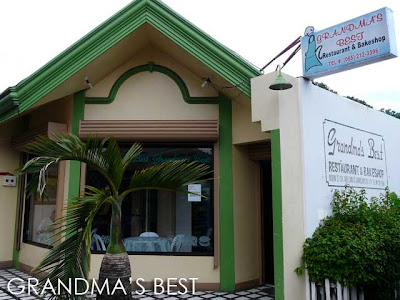

Grandma's Best
Mabini Street corner Arellano Street
(065) 2123396
This place is most known for it's desserts and pastries. But serves a wide range of dishes for breakfast, lunch and dinner. The menu had so much in it, it was so hard to decide what to eat. I tried out their Beef BBQ which was really good. If you have a problem picking out a dessert, just head on over to the fridge and see what's available. I got myself a Revel Bar and some Yema.
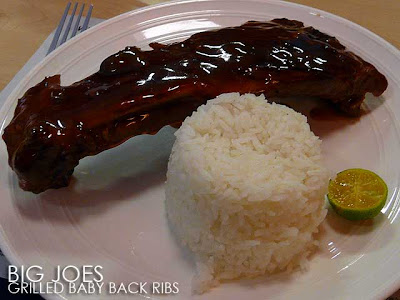
Big Joes!
General Luna Street
(065) 2122259 / 2124539
It's got burger and fries, fried chicken, Shawarma, rice meals and Filipino favorites such as Crispy Pata, Sisig and Lechon Kawali. But a must-try would be their steaks and Grilled Baby Back Ribs. And they have a delivery service too!
An Seafoods House
Arellano Street corner Zamora Street
(065) 2123252
While I'm not a seafood person as most of my friends know, I can't leave this restaurant out of the list. I checked out their menu and everything is seafood, even the burgers! Specialties include Sinugba, Tinola and Kinilaw (their version of STK it seems), plus the Seafoods Roll. They also have a branch along Capitol Drive.
Sunday, September 26, 2010
Zamboanga del Norte: Fantasyland & Gloria de Dapitan

Surprisingly for a provincial city, Dapitan has a nightlife area. Remember that theme park built by former Congressman Romeo Jaloslos which he named Gloria's Fantasyland? Well, that's it. The park is usually open from late afternoon until midnight. And I must say, the rides are quite good!

We were given a tour by the park manager (they have two managers in fact, one for operations in the evening, and one for maintenance during the day) and one thing he noted to us was cleanliness was very important to them. In fact, there wasn't even a piece of candy wrapper or dried leaves on the floor because if there was, he would pick it up.

Make sure to try the Horror House because I'm giving it an A for effort! There's a story actually when you enter as a guide narrates and takes you through the house. Her companion was supposedly lost inside and your job is to help him or her find the companion as you weave your way through the house. It's the usual scare tactics but very well-done.
I heard there's a screwdriver coaster in the works! Not even Metro Manila and its environs has that!
Aside from Dakak, the other place for dining options in Dapitan is Gloria de Dapitan, which is right beside the park. They have live bands there and several restaurants which offer dinner, drinks and pulutan. And surprisingly, the whole area has WiFi Internet access!
Friday, September 24, 2010
Zamboanga del Norte: Dapitan and the Rizal Shrine

Dapitan, Zamboanga del Norte will always be synonymous with National Hero Dr. Jose P. Rizal. In fact, the structural works of Rizal still exist in Dapitan until today. There are in fact three declared cultural properties in Dapitan all relating to Rizal, namely the Relief Map of Mindanao, the Rizal Shrine and the Dapitan Plaza Historical Landmark.

We first visited the monument which was constructed at the site where Rizal landed when he arrived in Dapitan in 1892. It's a tableau of statues depicting the events of his arrival. There is a marker of the National Historical Institute there to mark the event. It reads: On this beach of Sta. Cruz, Jose Rizal landed at 7:00 o'clock p.m. on July 17, 1892 to begin a life of an exile in Dapitan. With Captain Delgras and three artillery men, they walked through Sta. Cruz Street with a "farol de combate" to the Casa Real where he was presented to Don Ricardo Carnicero, Spanish Military governor of the District.
From there, we proceeded to the Dapitan Town Plaza which is a National Historical Landmark. Another NHI marker can be found there. It states that the plaza was layed-out according to the plans of Rizal while he was exiled there from 1892 to 1896 and that he himself planted the acacias around the plaza. He also provided the lighting system of the plaza powered by coconut oil which he funded from a payment of a British patient.
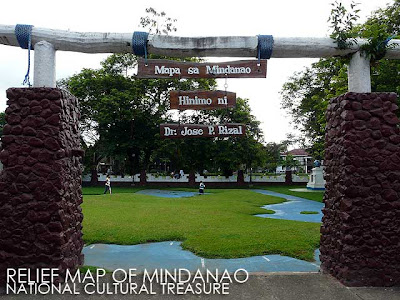
The Relief Map of Mindanao, a National Cultural Treasure, can also be found in the same plaza, right on front of the Dapitan Church. It was Rizal and his former teacher Fr. Francisco de Paula Sanchez, S.J. who constructed the map with the help of the church staff and the students of the parochial school of Dapitan in 1892. The map was restored during the term of Zamboanga Governor Jose Asiniero, a former student of Rizal.
Inside the Dapitan Church is another NHI marker which is located in the spot where Rizal stood every time he heard Mass. The marker reads: On this spot of St. James Church contructed by the Jesuits, Rizal stood while hearing Mass every Sunday during his exile in Dapitan in 1892-1896.

Around the plaza are several heritage structures including the City Hall of Dapitan, ruins of the Parochial School, and several ancestral houses. An NHI marker can also be found in the site of the Casa Real. It reads: This is the site of the Casa Real, official residence and administration building of the politico-military governor of the district. Here Rizal lived as an exile from July 17, 1892 to March, 1893 when he was transferred to Talisay, now the Rizal Dapitan Shrine.

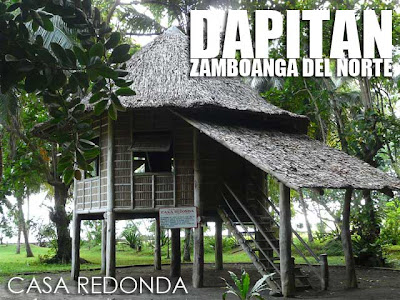
Our last stop for the afternoon was the Rizal Shrine, a National Shrine, where replicas of Rizal's house, classroom, clinic and other structures can be found. Also at the shrine is the rock where Jose Rizal and Josephine Bracken got married and the water system which Rizal constructed. There is also a museum which contains several personal items of Rizal including his clothes.
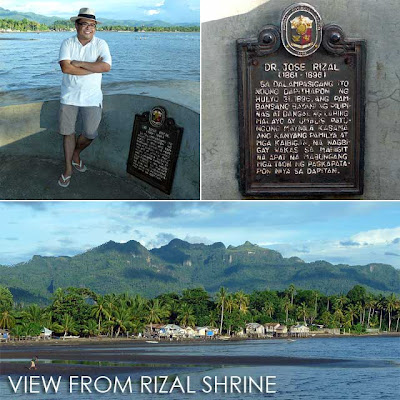
There are at least two NHI markers at the Rizal Shrine including one at the spot where Rizal left for Manila on July 31, 1896 with his family and friends, ending four years of fruitful exile in Dapitan.
There are two other towns with works and properties of Rizal, namely Dipolog and Kalayaan.
Part 1: Dakak Park Beach Resort in Dapitan
Thursday, September 16, 2010
Zamboanga del Norte: Dakak Park Beach Resort in Dapitan
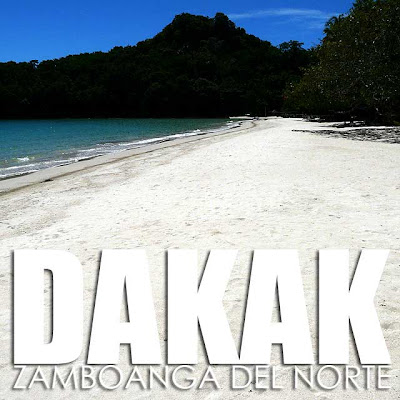
When flying to Dipolog, make sure to include Dakak Park Beach Resort in your itinerary. In fact, most tourists fly there to visit Dakak, a really popular beach resort which has maintained its quaint 1980s charm. Their representative picks you up at the Dipolog Airport which is about 45 minutes away from Dakak and conveniently ferries you to the resort in an air-conditioned van.
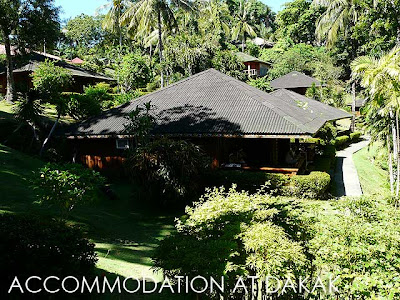
After checking in, we had to walk a small distance to get to our villa room. The resort is sprawling! They have swimming pools in the resort. But I personally liked the privacy of the beach at Dakak. You can just spend the whole afternoon on the lounge chairs for a relaxing nap. Or visit some of the nearby islands.
The afternoon we arrived, we went around the historic center of Dapitan which is full of memories of Jose Rizal's exile there. But I'll talk about that in another entry.
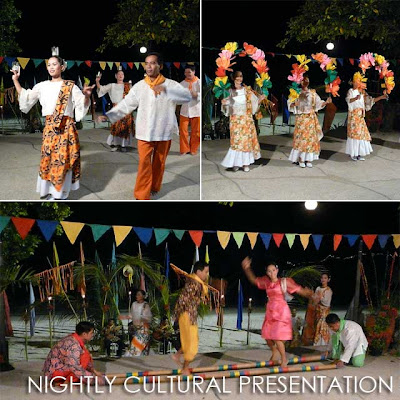
We went back to Dakak to try their popular dinner buffet. I've heard a lot of good stuff about their dinner buffets and I wasn't disappointed. But more than the food, it's the cultural performances which make the dining experience at Dakak complete. In fact, it was a showcase of Filipino songs and dances, including local Bisaya songs. The next night, it was a Hawaiian-themed cultural performance and they do it quite well.
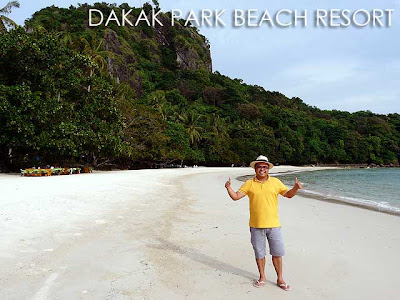
From Dakak, there are package tours available including city tours such as visits to Gloria de Dapitan and Gloria's Fantasyland, a cove hopping tour, visits to Aliguay and Selinog Island and the Dampa and Burgos River Cruise (take note that this boat leaves only at 11 a.m. and prior reservation is needed since there is a minimum of 10 people) similar to the one of the Loboc River in Bohol.
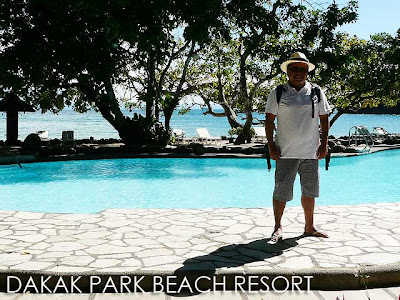
Dakak Park Beach Resort also has an Aqua Sports Facilities Center where you can rent boats, kayaks, hobbie cats, jetskis, go water skiing or take a banana boat ride. You can also rent scuba diving equipment and even go night diving! Other recreational activities include golf, bowling, billiards, horseback riding, tennis and mountain bike riding around the park among others.
Dakak Park Beach Resort
Taguilon, Dapitan City, Zamboanga del Norte
(0919) 7959416 / (0915) 3185238 / (065) 2136813
Manila: (02) 7241461 / 7247375
Cebu: (032) 2310200
Sunday, September 12, 2010
Zamboanga Sibugay: Around Ipil

Ipil is the provincial capital of Zamboanga Sibugay. I only had a few minutes in Ipil since I had to catch the bus back to Zamboanga City that same afternoon. So I visited the Zamboanga Sibugay Provincial Capitol which I saw on top of a hill.

It turns out when I got there that the capitol was still under construction. But once finished, I'm sure it will become a new landmark since the architecture is quite unique, not the ugly four walls and a roof which typifies government buildings in the country.

Our government engineers should start being creative because they're churning out some of the ugliest infrastructure in the world! Good thing Zamboanga Sibugay's capitol looks like it has some character. From the same hill, visitors are afforded a very nice view of Ipil and its environs.

According to the Department of Tourism, Zamboanga Sibugay is known for its natural attractions. Unfortunately, it will take at least a day or two to visit most of them. There's Tantanan Bay, Sibuguey Bay, and Takushari in Talusan which are fish sanctuaries endowed with several corals reefs that are ideal for snorkeling and diving.
On my wish list is Pandilusan Island in Payao, and Litayon Island in Alicia which has notable white sand beaches. The province also has several caves in Tungawan and Talusan, and Moalboal Cave in Titay. Waterfalls include Tagbilat, Dalisay, Tugop Muslim, Cobacob, Go-otoc, Malagandis, Basay and Palina Falls in Ipil.
Saturday, September 11, 2010
Zamboanga del Sur: Scenic Lake Wood in Lakewood

If South Cotabato has Lake Sebu and the T'boli, the province of Zamboanga del Sur has Lakewood and the Subanen. The main attraction is of course the 800-hectare Lake Wood which is sometimes referred to as Lake Lakewood. But the culture of the Subanen is not as highlighted as the culture of the T'boli is in Lake Sebu. The best place to enjoy the view of Lake Wood is at the Alindahaw Lakeview Resort in Brgy. Biswangan.
From Pagadian, vans leave every hour for Lakewood. While public buses pass through the Lakewood junction along the National Highway, the Alindahaw Lakeview Resort and the town proper are still several kilometers inside. So it's best to take these vans or hire a habal-habal when you get off at the junction. Or better yet, hire a private vehicle but note that after the resort, the road to Lakewood is not yet paved.
You'll have to be patient with the vans though. As I arrived at the van terminal which is in downtown Pagadian, I was told the van was about to leave. Then they tell me a few minutes later that the vans have a scheduled time of departure which was still 45 minutes away. When the time of departure came, I was informed there would be a slight delay because someone had just consigned a delivery of construction materials including plywood and G.I. sheets which they had to load and secure on top of the van. Along the way, we stopped for gas, stopped at a store to load sacks of rice, and stopped for passengers to get on and off. The ride from Pagadian to Lakewood took about an hour and 30 minutes.

Anyway, my plan was to get off at the town proper to find a habal-habal to bring me back to the junction so that I could stop along the way at scenic spots and the resort to take photos. The van passed by the Alindahaw Lakewood Resort on the way to the Lakewood town proper and I was able to glance at the view through the gates for a few seconds. It was truly stunning!
After the resort, the road gets rough and I was about to regret not getting off at the resort instead since it looked like it was going the rain. And it did rain when I arrived at the town proper. But the sun came out again.

Finding a habal-habal was a bit of a challenge and I had to walk around the town asking at the market, barangay hall and some sari-sari stores where I could find a habal-habal. I did find one after asking at a vulcanizing shop. Unfortunately the owner was busy at work so he called the guy at the barber shop if he was free. I had to wait for him to finish doing a haircut though before we went off.

On the way to the resort, it was quite sunny and I was able to take nice photos of some terraced rice paddies and the lake. But as we neared the resort, it started to rain again. So I had to make do with rainy shots of scenic Lake Wood.

The resort has accommodation and kayaks for those who want to row around the lake. It's a great place for a day-trip or overnight stay with the picturesque view. But the videoke is as vulgar as in most provincial resorts in the country. They have function halls anyway so I hope they can keep the noise contained so that others can savor some peace and quiet which is perfect for this wonderful panorama.
It didn't stop raining so we had no choice but to continue to the junction under the rain. By the time I reached the junction, I was soaking wet! But the trip to the lake was worth it! If only I could stay longer. From the bus stop near the junction, I boarded a bus to Ipil, Zamboanga Sibugay.
Friday, September 10, 2010
Zamboanga del Sur: Around Pagadian

Pagadian is the capital of Zamboanga del Sur and regional capital of Zamboanga Peninsula. The first thing you'll notice when you arrive in the city are its unusual tricycles which are inclined at about 30 to 40 degrees. The unique design of Pagadian's iconic tricycles add stability given the city's hilly terrain. It's quite amusing seeing 6 to 7 people (including the driver) jam-packed in this peculiar-looking tricycle.

Hoping on the tricycle is quite an experience. Getting on, especially the top level, is quite a challenge. Make sure to ride on one of these tricycles when in Pagadian.
The main attractions of Pagadian are beaches (Dao Dao Islands and White Beach), waterfalls (Lourdes, Lison Valley, Manga and Ditoray Falls) and caves (Twin Caves and Kendis Cave). This is one trip where I chose not to do research hoping to rely purely on the locals. Unfortunately, the hotel frontliners could not answer my queries about Pagadian's tourist attractions and I ended up seeing nothing major. The tourism office should train people on how to answer these queries.

They ended up pointing me to a beach resort in the town of Tukuran, which was a 45-minute jeep ride north of Pagadian. Baguio's Beach Resort was a bit too rocky. While Serena Beach Resort didn't have much of a beach and had a really noisy videoke! While videoke is an important national pastime, I've always advocated that it be kept in a contained area of a resort so as not to disturb other visitors who may have wanted to visit a beach for some peace and quiet.
Being regional capital, there are a good number of decent hotels in the city. Anyway, I decided to rest early instead since people had suggested I visit the town of Lakewood, Zamboanga del Sur. So my plan was to visit the town on the way back to Zamboanga City.
Zamboanga: Satti at Pilar Street and Canelar Street

Satti is an early morning dish sold in Zamboanga City. It's actually from Jolo, Sulu but was made popular in Zamboanga City. It was a good thing satti restaurants open as early as 4 a.m. in Pilar Street. So as soon as I arrived from Jolo, I went straight there for breakfast.

For an affordable Php50, you get eight sticks of beef satti and puso (rice) floating in a generous serving of the sweet and spicy sauce that accompanies the satti. There's also chicken satti and you can pick which chicken part you want. In one corner of the restaurant, one of the staff was slicing puso into small pieces preparing them in bowls where the satti and sauce would be added later.

Pilar Street has a lot of satti restaurants. But there's actually another satti place in Canelar Street if you're staying in a hotel near the airport. It's very close to Jollibee. Just make sure you visit in the morning since supply doesn't last until the evening.
Now I'm craving for satti! Does anyone know where to get satti in Metro Manila?
Tuesday, September 07, 2010
Sulu: Visiting Jolo, Bud Datu in Indanan and Quezon Beach in Patikul
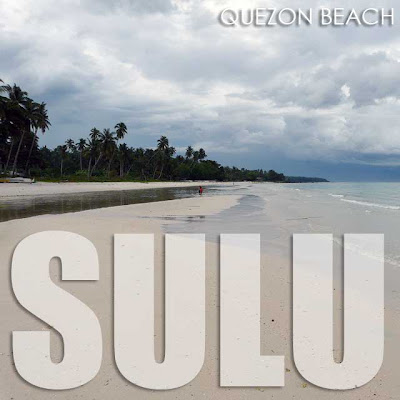
Sulu is indeed an island paradise. It's so unfortunate that the security situation there won't allow tourist arrivals for the meantime. But my curiosity pushed me to visit the island and see what was there. You can get to Jolo, Sulu from Zamboanga City since ferries leave Zamboanga Port every evening and arrive in Jolo at about four in the morning.
I spent Php620 for a cabin room bed (a cabin room accommodates four people). The regular aircon beds are Php470 which are all in one hallway. The cabin rooms have doors which you could lock. There are also flights to Jolo available from Zamboanga. Read Day-trip to Jolo for Part 1 of this trip.

After my quick nap, we proceeded to explore Jolo and the neighboring towns of Patikul and Indanan. We first dropped by the Sulu Provincial Capitol in Jolo. I noticed the centuries-old trees that lined the avenue that led to the Sulu Capitol. How I wish many of our old cities were able to preserve their trees.
You could also see the vernacular architecture hidden under the urban chaos of Jolo. If only the politicians there had the political will to clean up the city and preserve its character, Jolo would have been an even more fascinating town.
It's the gold domes that stand out in the Sulu Provincial Capitol. Beside the Sulu Capitol is the National Museum Sulu Branch which houses historical and cultural artifacts and exhibits on Sulu including the Sultanate of Sulu, as well as the Tausug and Badjao among others.
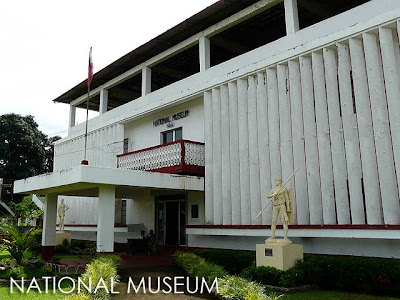
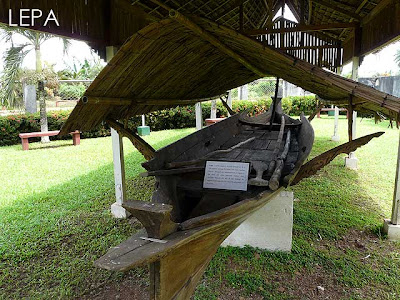
Outside the main building are statues of local heroes Panglima Unaid and Abduhalim Imao, as well as a century-old Bajau houseboat called a lepa.


I also got to taste the local Sulu variety of durian which was really good. And the prices shocked me. A basket of lansones (which looked like almost 8 kilos) was just Php70 or less than Php10 a kilo! The durian was just Php30 a piece or roughly Php15 a kilo. A bundle of mangosteen was just Php20 and my host told me that when in season, you could buy mangosteen for as low as Php5 a kilo!

We then visited the Central Mosque in Jolo. Unfortunately, I could only take a photo from the outside. There were a lot of people exiting the mosque since Friday prayers had just finished.

Lunch and the early afternoon was spent indoors since it started raining really hard. I walked to the nearby Jolo Cathedral when the rain stopped. In front of it was a Rizal Monument.
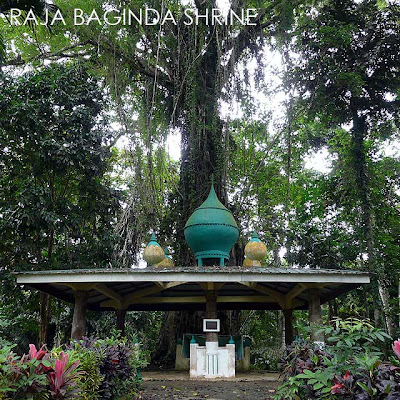

Later in the afternoon, we motored to the town of Indanan to visit Bud Datu where the grave of Raja Baginda, the first Muslim ruler of Sulu, is located. You'll have to enter a military camp to reach it. And since it's in a military camp, it's relatively well-maintained. But I'm sure the Raja Baginda Shrine can be improved to highlight the prominence of this Sulu pioneer in our nation's history. In fact, I'm surprised the National Historical Commission hasn't placed a marker there yet.
You can also see a nice panoramic view of Jolo from Bud Datu. But unfortunately, as we were walking from the Rajah Baginda Shrine to our vehicle, the sun disappeared again and it started to rain. So we ditched the view.

We had to wait the rain out again before proceeding to our last stop, said to be one of the best beaches in the Philippines with a wide expanse of white sand that could rival that of Boracay. It was about twelve kilometers from Jolo in the town of Patikul. Quezon Beach was highly-recommended with a caveat though: that I may need a security escort to visit.
My hosts didn't mention any of that so we proceeded to Quezon Beach. We passed by several military camps and check points along the road that went deeper into Patikul. I noticed the houses, very fine examples of vernacular architecture. They rarely used hollow blocks in Patikul. And I felt I entered a time warp as we drove through since these could have been the architecture of Maynilad when the Spaniards arrived there almost five centuries ago. Most of the wooden houses were elevated on stilts with covered porches on two sides. An elevated walkway connected the main house to another structure behind the house which served as a kitchen and cleaning area.

We finally reached Barangay Igasan and parked by the beach. There wasn't too much sun. But I could see that the beach was stunning even with the overcast skies. The beach was wide and the water was baby blue. I was told that further down the road, the sand was even finer, powder fine in fact to rival the best beaches of the country. But I had to save it for another day. I did not want to push my luck any further since it was starting to get dark. The sun and sand would have been an impeccable combination. But I guess I'll have to wait for another trip, hopefully when the situation is a bit better.
What I liked about the beach was that the houses were all made of native materials. So it really gave you that tropical feel. At least for now, it will stay that way. But I wonder how they would manage development there if the situation gets better.


Back in Jolo, we had dinner and I got to try more local meat dishes like pastir and pyesak. Relatives of my host, curious as to where I went, asked which places I visited. When I told them we came from Quezon Beach, I got startled reactions. One even asked my host if they really brought me there and said I was brave to even visit. It was only then that I found out that the area was where many of the kidnappings this year occurred.
After dinner, I was brought to the Jolo Port to catch the 8 p.m. ferry back to Zamboanga. It was the M.V. Kristel Jane 3 again and I got myself the same cabin room. I was back in Zamboanga City at 4 a.m. just in time for another satti breakfast. As soon as I was done, I rushed to the transport terminal in Guiwan to catch a bus to Pagadian.
Subscribe to:
Posts (Atom)

